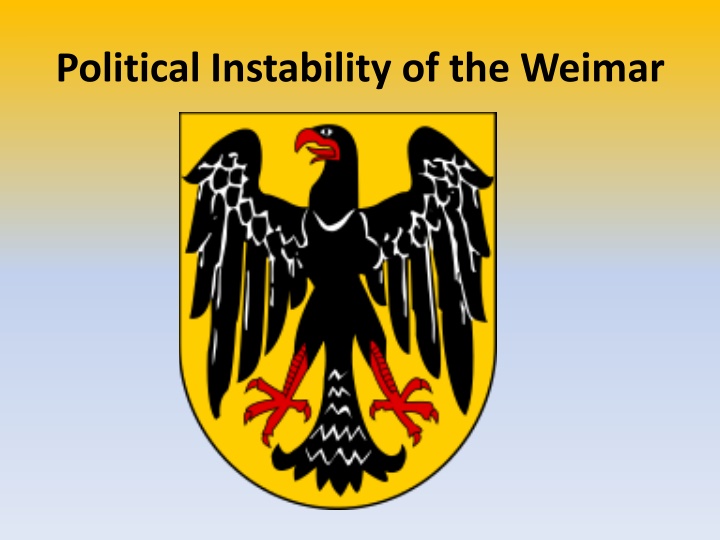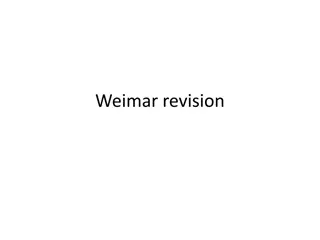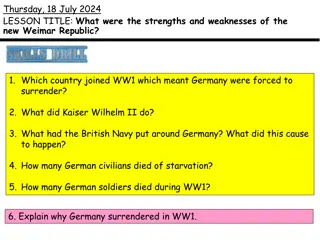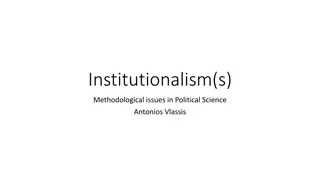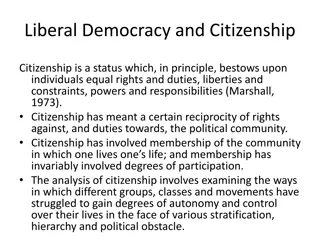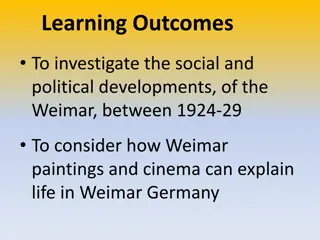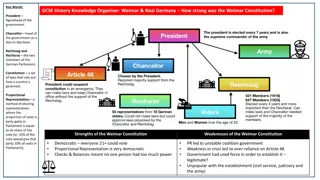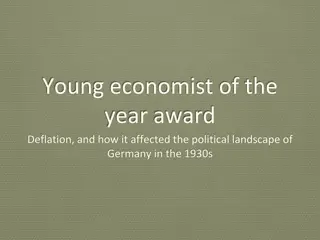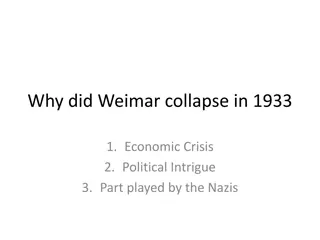Political Instability of the Weimar Republic: Spartacist and Kapp Putsches
The Weimar Republic faced political instability due to uprisings like the Spartacist and Kapp Putsches, rooted in dissatisfaction with its surrender to the Allies, weak constitution, and failure to address food shortages. The Spartacist Rising of January 1919, led by figures like Karl Liebknecht and Rosa Luxemburg, aimed to establish a communist state, culminating in clashes with the government and the formation of the German Communist Party. This turbulent period reflects the challenges the Weimar Republic encountered from both left-wing and right-wing threats.
Download Presentation

Please find below an Image/Link to download the presentation.
The content on the website is provided AS IS for your information and personal use only. It may not be sold, licensed, or shared on other websites without obtaining consent from the author.If you encounter any issues during the download, it is possible that the publisher has removed the file from their server.
You are allowed to download the files provided on this website for personal or commercial use, subject to the condition that they are used lawfully. All files are the property of their respective owners.
The content on the website is provided AS IS for your information and personal use only. It may not be sold, licensed, or shared on other websites without obtaining consent from the author.
E N D
Presentation Transcript
Learning Outcomes To investigate the Spartacist and Kapp Putsches To consider their causes, events and consequences
The Weimar was initially unpopular with many Germans because it: Surrendered to the allies Established a weak constitution Failed to end food shortages The Weimar faced constant threats from the left and right and there were several uprisings across Germany that threatened the Governments existence.
The Spartacist Rising January 1919 During the war, several groups emerged from the German Social Democratic Party (SPD) The most radical was the Spartacist league, named after a famous Roman gladiator who led a revolt in ancient Rome. Their leaders were Karl Liebknecht and Rosa Luxemburg who wanted to create a state based on communist ideals.
Karl Liebknecht Liebknecht became a communist while studying at the universities of Leipzig and Berlin. Liebknecht was very opposed to Germany fighting in WWI, though he was essentially a lone voice in Germany as few shared his belief. One who did was Rosa Luxemburg and they formed an underground organisation called the Spartacus League which printed an illegal newspaper called the Spartacus Letters . They got the name Spartacus after the slave who lead a failed revolt against the mighty Roman Army.
Rosa Luxemburg Rosa Luxemburg was a revolutionary who had fled form Poland. She was a brilliant speaker and writer and was leading socialist in Germany and was known a Red Rosa. She was imprisoned during WWI for spreading anti war propaganda and went Berlin once released to lead the Spartacists
The Spartacist Rising January 1919 In December 1918 the Spartacists demonstrations against the government led to clashes with the army and resulted in the deaths of 16 Spartacists. At the end of the month they formed the German Communist Party KPD
The Spartacist Rising January 1919 On the 6th January the Spartacists began their attempt to overthrow Ebert and the Weimar Government to create a communist state. They captured the headquarters of the governments newspaper and telegraph bureau, but they did not capture any other buildings.
The Spartacist Rising January 1919 Ebert used the regular army and the Berlin Freikorps to put down the rebellion.
The Spartacist Rising January 1919 On the 10th January the Freikorps took over the Spartacist headquarters and by the 15th the rebellion was crushed. A hundred Spartacists were killed compared to only thirteen Freikorps.
The Spartacist Rising January 1919 Liebknecht and Luxemburg were captured and murdered
The Spartacist Rising January 1919 Who Why What When Where
https://www.youtube.com/watch?v=zz OSf39wR_0
Exam question 1 [Spartacists outside the governments newspaper offices during their revolt in January 1919] Use Source D and your own knowledge to describe the Spartacist revolt in January 1919. [6]
The Kapp Putsch 1920 Having prevented a challenge from the left Ebert now faced on from the right. The Weimar announced in March 1920 that the size of the army was to be reduced and the Freikorps disbanded.
The Kapp Putsch 1920 This led to uproar in Berlin The leader of the Freikorps together with Wolfgang Kapp, a leading Berlin politician drew up a plan to seize Berlin and form a new right wing government with Kapp as chancellor.
The Kapp Putsch 1920 Kapp successfully seized Berlin on 13th March 1920 The regular army refused to put down the rising Ebert called on the people of Berlin not to support the Kapp Putsch and asked them to go on strike Trade unionist and civil servants supported the government and the Putsch collapsed Very few people were punished.
TASK Who was Wolfgang Kapp? Why did he call a revolt? What was his plan? How was the revolt put down?
